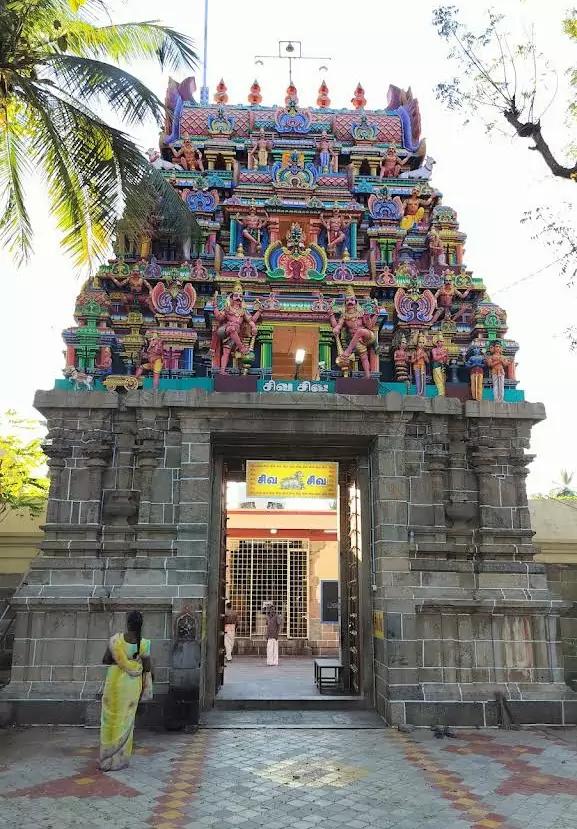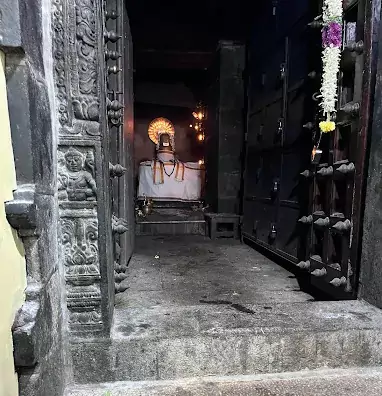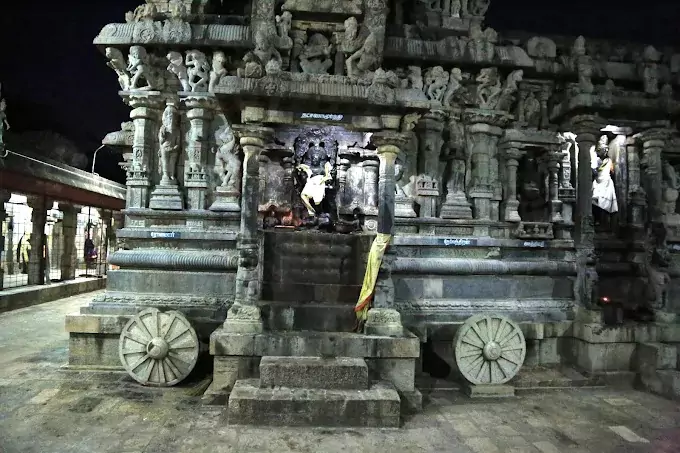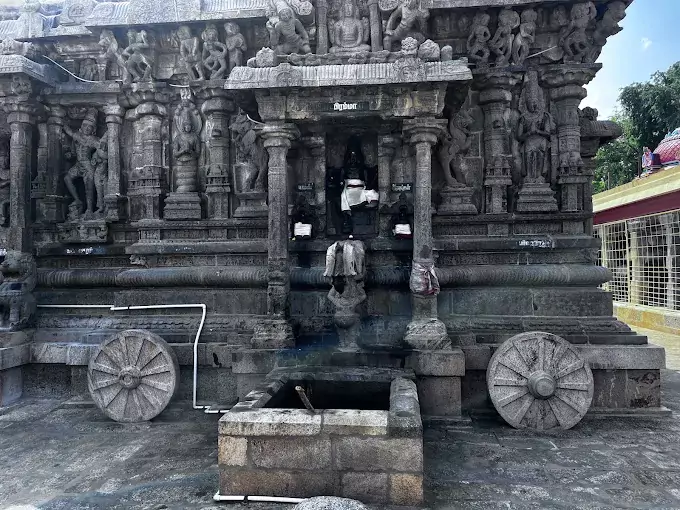- April 5, 2025

Contents
| Shiva Sthalam | Arulmigu Melakadambur Amirthakadeswarar Thirukkovil |
|---|---|
| Moolavar | Amirthakadeswarar |
| Utsavar | Somaskandar |
| Amman | Vidhyujothi Nayaki, Jothiminnammai |
| Theertham | Shakti Theertham |
| Thala Viruksham | Kadamba Tree |
| Purana Name | Thirukadambur |
| Town/Village | Melakadambur |
| District | Cuddalore |
Thennādudaiya Sivanē Pōtri
Ennāttavarkkum Iraivā Pōtri
Located in the Melakadambur village near Kattumannarkoil in the Cuddalore district of Tamil Nadu, the Amirthakadeswarar Temple is a magnificent temple with thousands of years of history and unique architecture. Standing as a testament to the artistic skill and deep devotion of the Cholas, this temple is notably mentioned in Kalki Krishnamurthy’s famous novel, Ponniyin Selvan.

History states that the Melakadambur Amirthakadeswarar Temple was built with granite stones in 1113 AD, during the 43rd year of the reign of Kulothunga Chola I. However, it is believed that a brick temple existed at this site before. This is one of the 276 Paadal Petra Sthalams (holy abodes of Shiva praised in the Tevaram hymns). The Nayanmars (Saivite saints) Thirunavukkarasar (Appar), Sundarar, and Thirugnanasambandar, who lived in the 7th and 9th centuries, have sung praises of this temple. It is the 34th Shiva temple located on the northern bank of the Kaveri River in the Chola country. Furthermore, the presence of a unique sculpture brought by Rajendra Chola I from the Pala dynasty further enhances the historical significance of this temple.
The main deity of this temple is a self-manifested Lingam (Shiva Lingam) known as Amirthakadeswarar, which means the Lord of the Pot of Nectar. This name is associated with the temple’s legend. The consort, Goddess, bestows her blessings as Vidhyujothi Nayaki. Uniquely, she appears to devotees in three different forms: as Saraswati (Goddess of knowledge) in the morning, as Lakshmi (Goddess of wealth) in the afternoon, and as Durga (Goddess of power) in the evening.
The Dasabuja Rishaba Thandavamoorthy statue here is very special. This rare form of Lord Shiva, with ten arms holding various weapons and dancing on a tiger, was brought from the Pala dynasty. This statue is displayed for devotees’ darshan only on Pradosham days.

The Melakadambur Temple belongs to the Karakoil type, one of the nine types of Shiva temple structures found in Tamil Nadu. It is built in the form of a chariot drawn by two horses with wheels. According to legend, the left wheel of the chariot is buried in the ground. Built in the Dravidian architectural style, the Vimana (tower above the sanctum) is entirely carved out of granite. Sculptures depicting scenes from the Ramayana, Krishna Leela, stories of the Nayanmars, and various forms of Shiva beautifully adorn the temple.
The Adhishtanam (base) of the temple has a Padmaga Bandham and Manjapathram structure with 18 layers. The three-tiered Rajagopuram (main tower) and two prakarams (enclosures) are the main features of this temple. Notably, unlike other Shiva temples, this temple does not have a Kodimaram (flagpole). In the Deva-koshtas (niches on the walls of the sanctum), Dakshinamurthy faces south, Vishnu faces west, and Brahma faces north.
The sacred tree of this temple is the Kadamba tree. The village was named Kadambur after this tree. Over time, it was divided into Melakadambur and Keelakadambur. The sacred water body of the temple is Shakti Theertham.
Several special events take place annually at the Melakadambur Temple. During the Panguni month (March–April) on the 3rd, 4th, and 5th, around 6:15 am, sunlight falls directly on the Amirthakadeswarar Lingam for fifteen minutes, which is a spectacular sight. Special pujas are performed at this time. Similarly, during the Aippasi month (October–November), moonlight fully illuminates the Lingam.
Origin of the Self-Manifested Lingam: According to legend, after the churning of the ocean (Samudra Manthana), the Devas (celestial beings) consumed the nectar (Amrita) without worshipping Lord Ganesha. Angered by this, Lord Ganesha took the pot of nectar and while traveling through the Kadamba forest, a drop fell and manifested as a self-formed Lingam. When the Devas realized their mistake and apologized to Lord Shiva, He appeared as Amirthakadeswarar and returned the nectar to them. The name is said to have originated from the words Amirtham (nectar pot), Kada (pot), and Eswarar (Lord).
Indra and the Chariot: Aditi, the mother of Indra (the king of the gods), used to visit this place daily to worship Shiva. Wishing to ease her difficulty, Indra tried to transform the temple into a chariot to take it to his celestial abode. However, without the permission of Ganesha, Ganesha used his power to press down the left wheel of the chariot into the ground. Realizing his mistake, Indra apologized to Shiva and installed a Lingam after chanting His name a thousand times. It is believed that Lord Shiva resides in Melakadambur, and Indra worships Him daily.
Murugan’s Worship: Before vanquishing Surapadman, Lord Muruga worshipped his mother here and received the Vel (spear) weapon from her. Hence, the festival deity here is called Villeendhiya Velavar (the Vel-bearing warrior). Since Angarakan (Mars), the lord of the planet Mars, worshipped Muruga here, Muruga is also seen as the deity associated with Mars in this temple.
Worship by Devas and Sages: In the Treta Yuga, Surya (Sun), Chandra (Moon), Indra, Romarishi, the Ashtaparvatas (eight mountains), and Parvatarajan (king of mountains) worshipped the Lord here. In the Kali Yuga, the sage Patanjali worshipped Amirthakadeswarar here.

Various festivals and rituals are celebrated with great fervor annually at the Melakadambur Amirthakadeswarar Temple:
Maha Shivaratri (February–March): A major festival celebrated with special pujas.
Aippasi Annabhishekam (October–November): A special event where the Shiva Lingam is anointed with cooked rice.
Arudra Darshanam (Margazhi Thiruvathirai, December–January): A festival celebrating the cosmic dance of Lord Shiva.
Panguni Uthiram (March–April): The auspicious time when sunlight falls directly on the Shiva Lingam.
Pradosham Pujas: On these days, the Dasabuja Rishaba Thandavamoorthy statue is displayed for devotees.
Purattasi (September–October): Commemorates the event of Goddess Parvati feeding Gnanasambandar.
Devotees visit the Melakadambur Amirthakadeswarar Temple for various reasons:
Remedy for Mars (Sevvai) Dosha: It is believed that offering red cloth to Lord Muruga here alleviates the malefic effects of the planet Mars.
Longevity: Performing Sashti Abda Poorthi (60th birthday celebrations) here is believed to bestow a long life.
Marriage and Child Boon: Offering turmeric and bangles to the Goddess is believed to remove obstacles in marriage and grant the boon of children.
Shakti Theertham: The sacred water body of the temple, Shakti Theertham, is believed to have medicinal properties.
Navabashanam: It is believed that the Lingam in this temple contains Navabashanam (a concoction of nine toxic substances used in Siddha medicine).
The Melakadambur Amirthakadeswarar Temple is a historical monument protected by the Archaeological Survey of India (ASI). Its mention in Kalki Krishnamurthy’s novel Ponniyin Selvan further enhances its cultural significance. Saints like Arunagirinathar, Vannasarabam Dandapani Swamigal, and Vallalar have also sung praises of the Lord of this temple. The inscriptions dating back to the 41st and 43rd years of Kulothunga Chola I confirm the early Chola origins of this temple.

Melakadambur village is located in the Cuddalore district (Pincode: 608304). The temple is about 6 km from Kattumannarkoil and about 32 km from Chidambaram. There is a Melakadambur bus stop on the Vadalur–Kumbakonam highway. From there, the temple can be easily reached by bus.
Arulmigu Amirthakadeswarar Thirukoil is open from 07:30 AM to 09:30 AM and from 05:00 PM to 08:00 PM.
The later mandapam (hall) of the temple has many beautiful bronze sculptures. Additionally, a Ganesha statue brought by Rajendra Chola I from the Vengi region is installed here. Notably, another similar Ganesha statue is in Thiruchenkattankudi.
Devotees visiting the Melakadambur Amirthakadeswarar Temple can also visit other nearby temples:
Kadambur Ilangoyil (Rudhrapathi Temple): Located about 1.5 km east of Melakadambur, this is a Vaipu Sthalam (a temple mentioned in the hymns of Saivite saints) and is also protected by the ASI.
Chidambaram Natarajar Temple: A world-famous Shiva temple located about 31 km away.
The Melakadambur Amirthakadeswarar Temple is a sublime confluence of spirituality, history, and architecture. Its unique chariot-like design, mythological stories, and Chola-era artistry make it a wonderful place that attracts devotees, history enthusiasts, and art lovers alike.
Melakadambur Sivan Temple Contact Number: +914142262646, +914142264638, +919345656982
Arulmigu Amirthakadeswarar Kovil,
Melakadambur Post,
Kattumannarkudi Taluk,
Cuddalore District,
PIN – 608304.